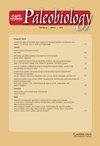Latitudinal influences on bryozoan calcification through the Paleozoic
IF 2.6
2区 地球科学
Q2 BIODIVERSITY CONSERVATION
引用次数: 0
Abstract
Abstract. Bryozoans are active non-phototrophic biomineralizers that precipitate their calcareous skeletons in seawater. Carbonate saturation states varied temporally and spatially in Paleozoic oceans, and we used the Bryozoan Skeletal Index (BSI) to investigate whether bryozoan calcification was controlled by seawater chemistry in Paleozoic trepostome and cryptostome bryozoans. Our results show that cryptostome bryozoan genera were influenced by ocean chemistry throughout the Paleozoic and precipitated the most calcite at lower latitudes, where carbonate saturation states are generally higher, and less in midlatitudes, where carbonate will be relatively undersaturated. Trepostome bryozoan genera show a similar but weaker trend for the Ordovician to Devonian, suggesting that, like the cryptostomes, they were unable to metabolically overcome falling saturation states and simply precipitated less robust skeletons at higher latitudes. Carboniferous to Triassic trepostomes differ, however, and show a trend toward increased calcification at higher latitudes, indicating an ability to overcome unfavorable carbonate saturation states. Analysis of Permian trepostomes at the species level indicates this is most pronounced in the Southern Hemisphere, where calcification is matched by increased feeding capacity. It is proposed that this increased feeding capacity allowed trepostomes to metabolically overcome unfavorable carbonate saturation states. The differing responses of trepostome and cryptostome bryozoans to carbonate saturation states suggest that bryozoans should not be considered as a single group in marine extinctions linked to ocean chemistry changes. Likewise, it would suggest that modern stenolaemate and gymnolaemate bryozoans should be treated separately when considering their response to modern ocean chemistry changes.古生代苔藓虫钙化的纬度影响
摘要苔藓虫是一种活跃的非光营养生物矿化剂,可在海水中沉淀其钙质骨骼。古生代海洋中碳酸盐饱和状态随时间和空间变化,我们使用苔藓虫骨骼指数(BSI)来研究古生代环口苔藓虫和隐口苔藓虫的苔藓虫钙化是否受海水化学控制。我们的研究结果表明,隐口苔藓虫属在整个古生代都受到海洋化学的影响,在碳酸盐饱和状态通常较高的低纬度地区沉淀的方解石最多,而在碳酸盐相对不饱和的中纬度地区则较少。树状苔藓虫属在奥陶纪至泥盆纪表现出类似但较弱的趋势,这表明,与隐口虫一样,它们无法在代谢上克服不断下降的饱和状态,只是在高纬度地区沉淀出不太坚固的骨骼。然而,石炭纪到三叠纪的钻孔虫有所不同,在高纬度地区表现出钙化增加的趋势,这表明它们有能力克服不利的碳酸盐饱和状态。对二叠纪钻孔虫物种水平的分析表明,这种情况在南半球最为明显,那里的钙化与进食能力的增加相匹配。有人提出,这种增加的进食能力使环口造口术能够代谢克服不利的碳酸盐饱和状态。环口苔藓虫和隐口苔藓虫对碳酸盐饱和状态的不同反应表明,在与海洋化学变化有关的海洋灭绝中,苔藓虫不应被视为一个单一的群体。同样,这也表明,在考虑现代海洋化学变化对现代狭窄苔藓虫和裸子苔藓虫的反应时,应该分别对待它们。
本文章由计算机程序翻译,如有差异,请以英文原文为准。
求助全文
约1分钟内获得全文
求助全文
来源期刊

Paleobiology
地学-古生物学
CiteScore
5.30
自引率
3.70%
发文量
38
审稿时长
>12 weeks
期刊介绍:
Paleobiology publishes original contributions of any length (but normally 10-50 manuscript pages) dealing with any aspect of biological paleontology. Emphasis is placed on biological or paleobiological processes and patterns, including macroevolution, extinction, diversification, speciation, functional morphology, bio-geography, phylogeny, paleoecology, molecular paleontology, taphonomy, natural selection and patterns of variation, abundance, and distribution in space and time, among others. Taxonomic papers are welcome if they have significant and broad applications. Papers concerning research on recent organisms and systems are appropriate if they are of particular interest to paleontologists. Papers should typically interest readers from more than one specialty. Proposals for symposium volumes should be discussed in advance with the editors.
 求助内容:
求助内容: 应助结果提醒方式:
应助结果提醒方式:


